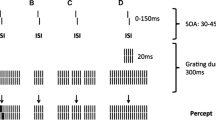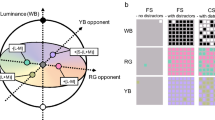Abstract
Most visual and cognitive functions are affected by aging over the lifespan. In this study, our aim was to investigate the loss in sensitivity to different classes of second-order stimuli—a class of stimuli supposed to be mainly processed in extrastriate cortex—in the aging population. These stimuli will then allow one to identify specific cortical deficit independently of visibility losses in upstream parts of the visual pathway. For this purpose, we measured the sensitivity to first-order stimuli and second-order stimuli: orientation-modulated, motion-modulated or contrast-modulated as a function of spatial frequency in 50 aged participants. Overall, we observed a sensitivity loss for all classes of stimuli, but this loss differentially affects the three classes of second-order stimuli tested. It involves all modulation spatial frequencies in the case of motion modulation, but just high modulation spatial frequencies in the case of contrast- and orientation modulations. These observations imply that aging selectively affects the sensitivity to second-order stimuli depending on their type. Since there is evidence that these different second-order stimuli are processed in different regions of extrastriate cortex, this result may suggest that some visual cortical areas are more susceptible to aging effects than others.

Picture Alexandre Reynaud, wikimedia commons/CC-0

Adapted from Reynaud et al. [33]







Similar content being viewed by others
References
Faubert J (2002) Visual perception and aging. Can J Exp Psychol 56:164–176
Owsley C (2016) Vision and aging. Annu Rev Vis Sci 2:255–271
Spear PD (1993) Neural bases of visual deficits during aging. Vis Res 33:2589–2609
Martínez-Roda JA, Vilaseca M, Ondategui JC et al (2016) Effects of aging on optical quality and visual function. Clin Exp Optom 99:518–525
Owsley C, Sekuler R, Siemsen D (1983) Contrast sensitivity throughout adulthood. Vis Res 23:689–699
Sekuler R, Hutman LP (1980) Spatial vision and aging. I: contrast sensitivity. J Gerontol 35:692–699
Greene HA, Madden DJ (1987) Adult age differences in visual acuity, stereopsis, and contrast sensitivity. Am J Optom Physiol Opt 64:749–753
Habak C, Faubert J (2000) Larger effect of aging on the perception of higher-order stimuli. Vis Res 40(8):943–950
Tang Y, Zhou Y (2009) Age-related decline of contrast sensitivity for second-order stimuli: earlier onset, but slower progression, than for first-order stimuli. J Vis 9:18. https://doi.org/10.1167/9.7.18
Jamar JH, Koenderink JJ (1985) Contrast detection and detection of contrast modulation for noise gratings. Vis Res 25:511–521
Schofield AJ, Georgeson MA (1999) Sensitivity to modulations of luminance and contrast in visual white noise: separate mechanisms with similar behaviour. Vis Res 39:2697–2716
Kingdom FA, Keeble D, Moulden B (1995) Sensitivity to orientation modulation in micropattern-based textures. Vis Res 35:79–91
Landy MS, Oruç I (2002) Properties of second-order spatial frequency channels. Vis Res 42:2311–2329
Reynaud A, Hess RF (2012) Properties of spatial channels underlying the detection of orientation modulations. Exp Brain Res 220:135–145
Meso AI, Hess RF (2010) Visual motion gradient sensitivity shows scale invariant spatial frequency and speed tuning properties. Vis Res 50:1475–1485
Watson AB, Eckert MP (1994) Motion-contrast sensitivity: visibility of motion gradients of various spatial frequencies. J Opt Soc Am A 11:496–505
Arsenault AS, Wilkinson F, Kingdom FA (1999) Modulation frequency and orientation tuning of second-order texture mechanisms. J Opt Soc Am A Opt Image Sci Vis 16:427–435
Ellemberg D, Allen HA, Hess RF (2006) Second-order spatial frequency and orientation channels in human vision. Vis Res 46:2798–2803
Zavitz E, Baker CL (2013) Texture sparseness, but not local phase structure, impairs second-order segmentation. Vis Res 91:45–55
Baker CL (1999) Central neural mechanisms for detecting second-order motion. Curr Opin Neurobiol 9:461–466
Chubb C, Landy M (1991) Orthogonal distribution analysis: a new approach to the study of texture perception. In: Landy M, Movshon J (eds) Computational models of visual processing. MIT Press, Cambridge
Hallum LE, Landy MS, Heeger DJ (2011) Human primary visual cortex (V1) is selective for second-order spatial frequency. J Neurophysiol 105:2121–2131
Kastner S, Weerd PD, Ungerleider LG (2000) Texture segregation in the human visual cortex: a functional MRI study. J Neurophysiol 83:2453–2457
Larsson J, Heeger DJ, Landy MS (2010) Orientation selectivity of motion-boundary responses in human visual cortex. J Neurophysiol 104:2940–2950
Larsson J, Landy MS, Heeger DJ (2006) Orientation-selective adaptation to first- and second-order patterns in human visual cortex. J Neurophysiol 95:862–881
Reppas JB, Niyogi S, Dale AM et al (1997) Representation of motion boundaries in retinotopic human visual cortical areas. Nature 388:175–179
Zeki S, Perry RJ, Bartels A (2003) The processing of kinetic contours in the brain. Cereb Cortex 13:189–202
Demb JB, Zaghloul K, Sterlingr P (2001) Cellular basis for the response to second-order motion cues in Y retinal ganglion cells. Neuron 32:711–721
Gharat A, Baker CL (2012) Motion-defined contour processing in the early visual cortex. J Neurophysiol 108:1228–1243
Rosenberg A, Husson TR, Issa NP (2010) Subcortical representation of non-Fourier image features. J Neurosci 30:1985–1993
Hou F, Huang CB, Lesmes L et al (2010) qCSF in clinical application: efficient characterization and classification of contrast sensitivity functions in amblyopia. Investig Ophthalmol Vis Sci 51(10):5365–5377. https://doi.org/10.1167/iovs.10-5468
Lesmes LA, Lu ZL, Baek J et al (2010) Bayesian adaptive estimation of the contrast sensitivity function: the quick CSF method. J Vis 10:17–21. https://doi.org/10.1167/10.3.17
Reynaud A, Tang Y, Zhou Y et al (2014) A normative framework for the study of second-order sensitivity in vision. J Vis. https://doi.org/10.1167/14.9.3
Yan F-F, Hou F, Lu Z-L et al (2017) Efficient characterization and classification of contrast sensitivity functions in aging. Sci Rep 7:5045
Gao Y, Reynaud A, Tang Y et al (2015) The amblyopic deficit for 2nd order processing: generality and laterality. Vis Res 114:111–121
Brainard DH (1997) The psychophysics toolbox. Spat Vis 10:433–436
Kleiner M, Brainard D, Pelli D (2007) “What’s new in Psychtoolbox-3?” Perception 36 ECVP abstract supplement
Pelli DG (1997) The VideoToolbox software for visual psychophysics: transforming numbers into movies. Spat Vis 10:437–442
Prins N, Kingdom FAA (2018) Applying the model-comparison approach to test specific research hypotheses in psychophysical research using the palamedes toolbox. Front Psychol 9:1250. https://doi.org/10.3389/fpsyg.2018.01250
Watson AB, Ahumada AJ Jr (2005) A standard model for foveal detection of spatial contrast. J Vis 5:717–740
Ahumada AJ Jr, Peterson HA (1992) Luminance-model-based DCT quantization for color image compression. In: Rogowitz BE (ed) Human vision, visual processing, and digital display III. Proceedings of the SPIE, vol 1666, p 365Y374
Lu Z-L, Chu W, Dosher BA et al (2005) Perceptual learning of Gabor orientation identification in visual periphery: complete inter-ocular transfer of learning mechanisms. Vis Res 45:2500–2510
Bunce C, Patel KV, Xing W et al (2014) Ophthalmic statistics note 1: unit of analysis. Br J Ophthalmol 98:408–412
Matthews JN, Altman DG, Campbell MJ et al (1990) Analysis of serial measurements in medical research BMJ 300:230–5
Lewontin RC (1966) On the measurement of relative variability. Syst Zool 15:141–142
Busey T, Craig J, Clark C et al (2010) Age-related changes in visual temporal order judgment performance: relation to sensory and cognitive capacities. Vis Res 50:1628–1640
Spiegel DP, Reynaud A, Ruiz T et al (2016) First- and second-order contrast sensitivity functions reveal disrupted visual processing following mild traumatic brain injury. Vis Res 122:43–50
Kingdom FAA, Prins N, Hayes A (2003) Mechanism independence for texture-modulation detection is consistent with a filter-rectify-filter mechanism. Vis Neurosci 20:65–76
Cropper SJ, Kvansakul JGS, Johnston A (2009) The detection of the motion of contrast modulation: a parametric study. Attent Percept Psychophys 71:757–782
Wang Z, Yao Z, Yuan N et al (2014) Declined contrast sensitivity of neurons along the visual pathway in aging cats. Front Aging Neurosci 6:163
Yang Y, Liang Z, Li G et al (2008) Aging affects contrast response functions and adaptation of middle temporal visual area neurons in rhesus monkeys. Neuroscience 156:748–757
Woi PJ, Kaur S, Waugh SJ et al (2016) Visual acuity measured with luminance-modulated and contrast-modulated noise letter stimuli in young adults and adults above 50 years old. F1000Research 5:1961
Higgins KE, Jaffe MJ, Caruso RC et al (1988) Spatial contrast sensitivity: effects of age, test-retest, and psychophysical method. J Opt Soc Am A Opt Image Sci 5:2173–2180
Santos NA, Oliveira AB, Nogueira RMTBL et al (2006) Mesopic radial frequency contrast sensitivity function for young and older adults. Braz J Med Biol Res 39:791–794
Bennett PJ, Sekuler R, Sekuler AB (2007) The effects of aging on motion detection and direction identification. Vis Res 47:799–809
Hua T, Kao C, Sun Q et al (2008) Decreased proportion of GABA neurons accompanies age-related degradation of neuronal function in cat striate cortex. Brain Res Bull 75:119–125
Leventhal AG, Wang Y, Pu M et al (2003) GABA and its agonists improved visual cortical function in senescent monkeys. Science 300:812–815
Schmolesky MT, Wang Y, Pu M et al (2000) Degradation of stimulus selectivity of visual cortical cells in senescent rhesus monkeys. Nat Neurosci 3:384–390
Ozeki H, Sadakane O, Akasaki T et al (2004) Relationship between excitation and inhibition underlying size tuning and contextual response modulation in the cat primary visual cortex. J Neurosci 24:1428–1438
Serrano-Pedraza I, Romero-Ferreiro V, Read JCA et al (2014) Reduced visual surround suppression in schizophrenia shown by measuring contrast detection thresholds. Front Psychol 5:1431
Tadin D, Kim J, Doop ML et al (2006) Weakened center-surround interactions in visual motion processing in schizophrenia. J Neurosci 26:11403–11412
Yoon JH, Maddock RJ, Rokem A et al (2010) GABA concentration is reduced in visual cortex in schizophrenia and correlates with orientation-specific surround suppression. J Neurosci 30:3777–3781
Betts LR, Taylor CP, Sekuler AB et al (2005) Aging reduces center-surround antagonism in visual motion processing. Neuron 45:361–366
Pardhan S, Gilchrist J, Elliott DB et al (1996) A comparison of sampling efficiency and internal noise level in young and old subjects. Vis Res 36:1641–1648
Hallum LE, Movshon JA (2014) Surround suppression supports second-order feature encoding by macaque V1 and V2 neurons. Vis Res 104:24–35
Acknowledgements
This work was supported by National Natural Science Foundation of China Grants (NSFC 31300913) to YT and (NSFC 81261120562) to YZ and by Canadian Institutes of Health Research Grants CCI-125686 and MT-10818 to RFH.
Author information
Authors and Affiliations
Corresponding author
Ethics declarations
Conflict of interest
On behalf of all authors, the corresponding author states that there is no conflict of interest.
Statement of human and animal rights
This research has been approved by the ethics committee of the University of Science and Technology of China, and by the Ethics Review Board of the Montreal Neurological Institute. It was performed in accordance with the ethical standards laid down in the 1964 Declaration of Helsinki.
Informed consent
Informed consent was obtained before participation.
Electronic supplementary material
Below is the link to the electronic supplementary material.
40520_2018_1018_MOESM1_ESM.pdf
Supplementary material 1 Figure A1. Individual sensitivity functions of the 50 participants. The sensitivity functions are shown for the first-order oriented carrier (light blue, LM1d), the first-order moving carrier (light red, LM2d), the contrast modulation (green, CM), the orientation modulation (dark blue, OM), and the motion modulation (dark red, MM). Sensitivity functions are colored with light shades for the dominant eye (DE) and dark shades for the non-dominant eye (NDE) (PDF 937 KB)
Rights and permissions
About this article
Cite this article
Reynaud, A., Tang, Y., Zhou, Y. et al. Second-order visual sensitivity in the aging population. Aging Clin Exp Res 31, 705–716 (2019). https://doi.org/10.1007/s40520-018-1018-6
Received:
Accepted:
Published:
Issue Date:
DOI: https://doi.org/10.1007/s40520-018-1018-6




